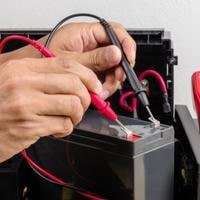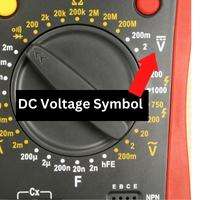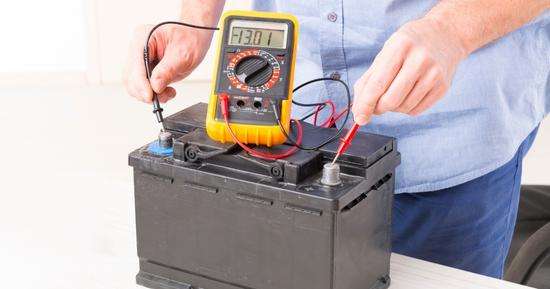Batteries should also be examined like other appliances to confirm maximum output while required. If you are facing poor ignition or other functions such as blinking dashboard lights, or poor control over electronic windows, you need to test your car battery.
With a multimeter, you can quickly test the voltage and amps of a battery to determine the battery’s health.
This post will discuss how to test a battery and alternator with a multimeter.
Table of Contents
ToggleHow to test battery with a multimeter?
- Set your multimeter to DC volts (V⎓) to test a battery.
- Adjust multimeter voltage above the battery max voltage, such as 15 or 20 V for 12.6 volts battery.
- Connect the red probe to the positive(+) and the black probe to the negative(-) battery terminal.
- While the battery is fully charged, the voltage must be between 12.4-12.9 volts for a 12.6-volt battery.
- While the engine is on, the battery voltage should increase up to 1.5 volts, then the voltage at the engine should be off and between 13.8-14.4 volts.
Follow Step by step guide below:
Step 1: Prepare battery for testing
If you are testing a car battery, first locate the battery. Consult the manual for google your car’s model battery location.
Next, determine if corrosion or dirt is present at the positive and negative terminals. It is essential to scrub the corroded terminal of the battery for accurate voltage measurement.
After the terminals have been cleaned, they can be used as connection points for multimeter probes.
There is a + sign on the battery-positive terminal, and a red wire is used. A black wire is used on the negative terminal, which is assigned a – sign.
Precaution: You should wear gloves to prevent skin contact with harmful chemicals and battery acid.
Step 2: Set the multimeter to DC Voltage
- Set the multimeter dial to the DC voltage indicated by the V⎓ or VDC sign to test the electrical output of a vehicle’s battery.
- If you have a 12.6 V battery, the multimeter should be set to the 15-20 V range.
- Insert the red probe into the VΩmA port on the multimeter and the black probe into the COM port.
- Connect the multimeter red probe (needle end) to the battery’s positive terminal and the black probe to the battery’s negative terminal.
Step 3: Evaluate battery from multimeter reading
- Your battery is safe if the multimeter reads 12.6 V while the engine is off or the battery is unplugged from wires.
- While the engine starts, the normal battery voltage is 13.7 to 14.4 volts.
- The battery could be dead or faulty if your battery voltage is below 12 volts.
- Ideally, the resting voltage should not be lower than 12.6V.
- If the multimeter displays a negative voltage (-12.6 instead of 12.6), likely, you have connected multimeter probes to opposite terminals.
Tip: Check the date labeled on the battery. It’ll help you decide if the battery is old or fine. A battery should be alive for 4 years.
Signs of a poor battery
Check the battery for faults if you notice any of these symptoms:
- Physical problems like heating, leaking and bulging.
- The battery cannot hold a charge.
- The battery charges 100 percent quickly, but then it drains too quickly.
- The voltage across the battery’s terminals is too low compared to the label’s rated voltage.
How to test alternator with a multimeter
An alternator generates electricity and charges the battery while you drive. With the engine running, conduct
the same battery testing as before with your multimeter. We can evaluate an alternator by testing the battery’s voltage with a multimeter while the engine is on and off.
- Check the voltage of your car battery while the engine is off and on. The alternator works fine if the battery voltage increases by 1.5 volts after starting the engine.
- For example, if the battery voltage is 12.6 while the engine is off, it should be between 13.8 to 14.5V at an average speed.
- If your car’s voltage is outside this range, it could be under or overcharged and will reduce the battery’s life.
- If you install a new tested battery, a faulty alternator cannot share the battery while the engine is running.
See this article for more information about the car’s charging system.
Frequently Asked Questions
-
How to test battery amps with a multimeter?
To test the amps of your battery, set your multimeter to DC amps (A⎓), and adjust the range to 10 or 20 Amps.
Connect the red probe to the positive battery terminal and the black probe to the negative battery terminal.
Find the ideal amps range on your battery or manufacturer manual to compare them with the multimeter readings.
-
How to test battery drain with a multimeter?
When your car cannot start, especially on cold mornings, or essential functions fail, such as dim lights, it’s a sign of a faulty or low-charged battery.
If the multimeter shows less than 12.6 volts, disconnect and charge it fully with a battery charger. Again check the voltage of the battery after a night with a multimeter.
The battery drains if voltage decreases without connecting it back to the car or any other appliance.
-
How to check car battery health without a multimeter
You can also test a car battery without a multimeter. Turn on the light of your car and check if the light is dim or bright. If the lights are dim, you should recharge or replace the battery
-
How to find dead cells in a car battery
If your fully charged car battery displays only 10-11 volts, it has a dead cell.
Your vehicle battery has dead cells when it cannot produce enough amperage to start and operate components like the lights.
Conclusion
Testing a battery with a multimeter makes it easy to decide if you have to replace it. Your car’s 12.6-volt battery should read 12. 4-12.8 wire disconnected from the circuit(engine) and 13.8-14.4 volts while connected to a running engine. Also, measure the amps of your battery and compare them with the battery’s ideal amp range.
This way, you can test batteries of any range with a multimeter. Share this article if you find it helpful, and share your queries in the comments.
Related Guides:







